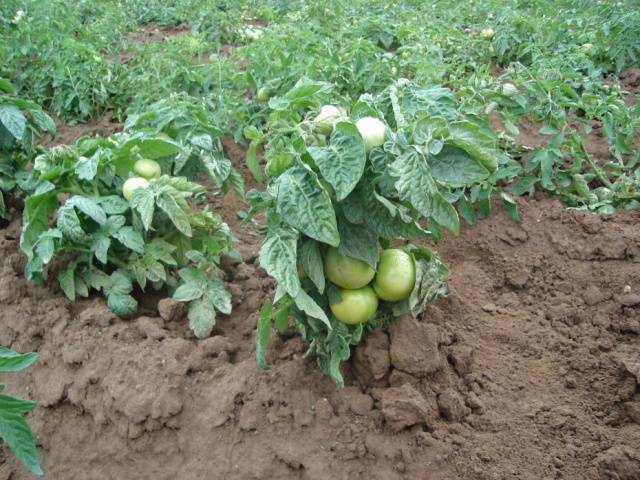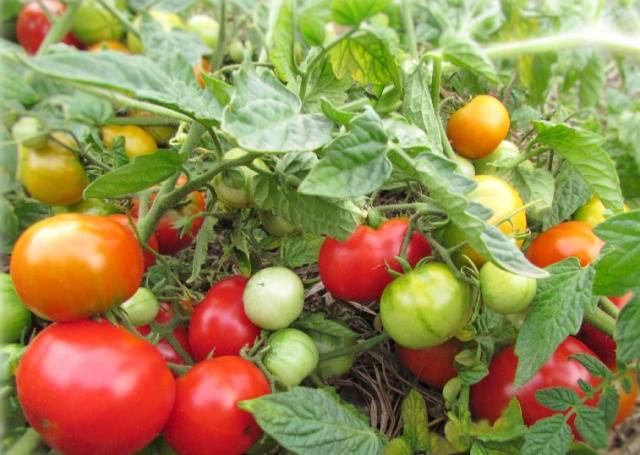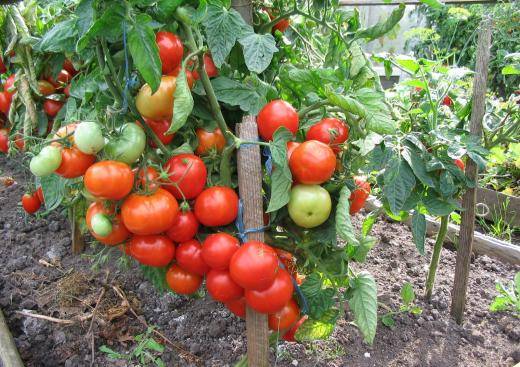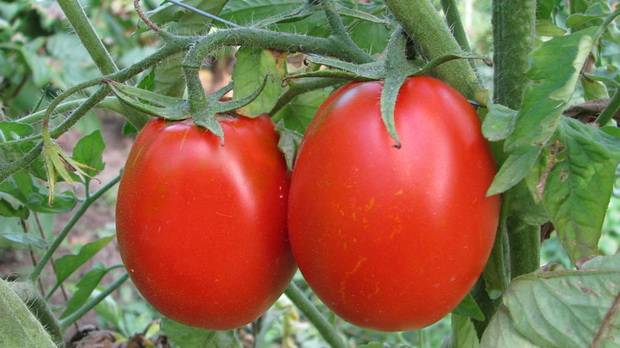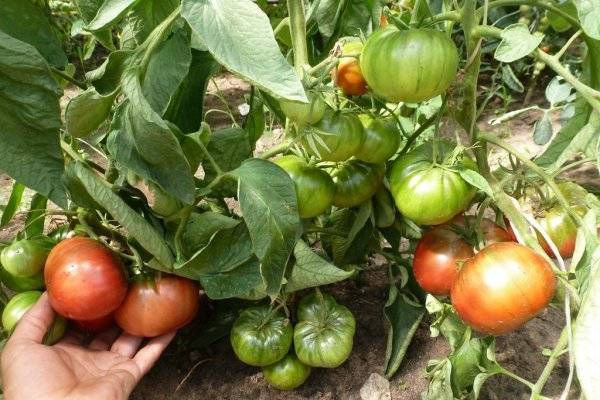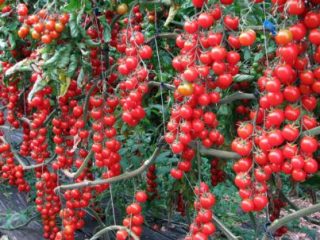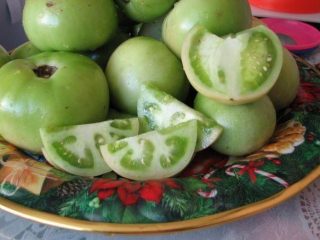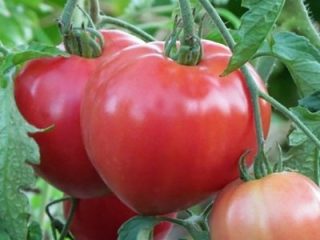Content
Early ripening tomatoes all belong to the group of determinate varieties. Due to the limited growth of the stems, the ovaries on them are formed almost simultaneously and the ripening of the fruits occurs smoothly and in a short time.
Determinate tomatoes can be super-determinate and determinate without the prefix “super”.
The former are distinguished by very low growth and super early ripening of the crop. They do not need stepsons, since the fruits are set on the stepsons. Tying is required when growing high-yielding tomato variety, the branches of which may not withstand the weight of the fruit, or a productive year when a lot of tomatoes are formed even on not very productive varieties.
Determinate ones grow taller superdeterminants and, as a rule, need a garter. Among them there are early and mid-ripening varieties. Determinants take stepson, usually growing a bush with two stems. The second stem is obtained from the stepson that grew under the first cluster of flower buds. For some varieties, growing with three stems is optimal.
There is another group of determinate varieties, called standard varieties. These are usually low, stocky bushes with a strong stem that look like miniature trees.They don't require formation and tying. There are standard varieties of tomatoes up to 1 m high. In this case, support may be required.
The height of determinate varieties varies from 40 to 100 cm. Depending on the manufacturer’s recommendations, such tomatoes are planted at an average distance of 0.5 m with row spacing of 0.6-0.7 m. Sometimes the variety allows for closer planting.
When choosing tomato varieties of any type for your plot, it is very important to pay attention to the zoning of the variety. In the north of the country it is possible to grow only determinate varieties, indeterminate they won’t have time to ripen there. In the south, indeterminate plants can be planted in greenhouses.
The best varieties of determinate tomatoes
"Turbojet"
Indeed, the best variety of tomatoes of all the new products that appeared on sale in the 2017 season. True, it has a serious drawback: gardeners who tried to plant it in the summer cannot find “Turbojet” seeds on sale this year. Either they hadn’t delivered it yet, or they liked it so much that the gardeners who managed to catch it bought seeds in huge quantities and supply couldn’t keep up with demand.
This is a super-determinate, very compact bush, 0.4 m high, completely covered with fruits. There is no need to sapling it, and this is impossible, since tomatoes are formed precisely on the saplings.
The tomatoes are small, 70 g, but there are a lot of them, so a garter is advisable. According to reviews from those who tried to plant tomatoes last year, the variety is “ultra-super early.” It was sown for seedlings in March. After planting in the open air, ripe tomatoes were picked in early July. At the same time, the variety is not afraid of cold weather and grows well in open beds in the Middle Zone and beyond the Urals, producing good yields in cold summers.The tomato is not very suitable for growing in the south due to the too small area of foliage that does not cover the fruits from the sun. The tomato is not very suitable for growing in the south due to the too small area of foliage that does not cover the fruits from the sun.
A versatile tomato with a pleasant taste.
Plant tomato bushes “Turbojet” at a distance of 40 cm with a row spacing of 50 cm.
"Alpha"
A determinate super-early variety of standard type, perfectly suitable for growing in the cold regions of Russia. Bush height up to 55 cm.
With the seedless growing method, fruit ripening begins already on the 85th day after sowing. In the central zone, the variety is grown in open beds, in more severe climates in film shelters.
In the south, the variety bears fruit at the beginning of summer, in the north in mid-July. Entered into the state register in 2004.
Tomatoes have thick, straight stems and potato-like leaves. To form a strong trunk, the stepsons are removed from the lower part.
The bush produces bright red tomatoes of small size, weighing about 55 g, and round in shape. Recommended for use in cooking or fresh.
The variety, despite its low growth, is productive. Up to 7 kg of fruits are collected per unit area.
The variety is resistant to diseases that are most dangerous for tomatoes. In addition, he manages to harvest the entire harvest before late blight and other fungal diseases appear.
Features of cultivation
For "Alpha", which is an actively growing tomato variety, areas with fertile soil, well-lit by the sun and without the possibility of water stagnation are selected. To form more roots, the soil under the tomatoes must be periodically loosened and the bushes lightly hilled.
"Valentina"
Developed at the Nikolai Ivanovich Vavilov Institute and recommended for outdoor cultivation.
The tomato is intended for growing on personal plots and farmsteads. A determinate early-ripening variety, the bush is not standard with a small amount of foliage, which indicates its zoning in the northern regions of Russia. The height of the bush is up to 0.6 m. Tomatoes ripen 105 days after sowing. The variety requires pinching and tying.
Experienced gardeners say that stepsons should be removed only when growing bushes of this variety of tomatoes in a greenhouse. In open ground, removing stepsons reduces the yield of a bush.
The inflorescences are simple, borne through 1-2 leaves.
When ripe, the fruits are orange-red in color. Plum-shaped tomato shape, weight up to 90 g. Purpose of the variety: whole-fruit canning and culinary processing.
Tomatoes contain up to 4.5% saccharides and up to 21 mg/100 g of dry matter vitamin C.
The yield of "Valentina" is average. When planting 6-7 bushes per m², you get up to 12 kg of tomatoes. The yield of one bush can be up to 3 kg.
The advantages of the variety include:
- good keeping quality and transportability of tomatoes;
- ability to tolerate slight drought;
- resistance to major diseases;
- unpretentiousness in cultivation.
Gardeners cited the need to tie up bushes as a disadvantage.
At a tomato competition held by gardeners in 2000, “Valentina” came out on top in terms of its positive qualities.
"Explosion"
Hybrid. A super-determinant non-standard tomato variety, which is a modernization of the “White Naliv” variety. It differs from its ancestor in the ability to grow without seedlings, cold resistance, moisture and drought resistance, calm attitude to temperature changes and dislike of greenhouses. A very small number of gardeners manage to obtain good yields of this variety in greenhouse conditions. Tomatoes also do not need a large amount of fertilizers.
The height of the bush is the same as “White filling” and does not exceed 65 cm. 105 days after sowing, the “Explosion” tomato produces round, slightly ribbed tomatoes weighing 250 g. One bush produces up to 3 kg of delicious tomatoes.
The “Explosion” variety is used for canning, cooking and making salads.
The advantages of the variety include:
- friendly return of the harvest;
- disease resistance;
- good tomato taste;
- high yield even in unfavorable weather conditions and unpretentiousness;
- excellent keeping quality and transportability.
There are no disadvantages.
Features of cultivation
This tomato variety has very high seed germination and ripening speed, so it can be grown both by seedlings and without seedlings.
Standard dates for sowing seeds of this tomato variety: March – April.
Before sowing, the seeds are kept for 6 hours in melt water, which is a growth stimulant. If desired and the availability of juice, you can additionally soak the seeds in aloe juice. Next, the seeds are dried and sown in warm soil.
Tomatoes are planted according to a 50x40 cm pattern. When sprouts appear, they are watered at the rate of half a glass of water per week per sprout. After the leaves appear, the plants need a glass of water.
During the growing season, the tomato is fertilized 4 times using mineral and organic fertilizers.
How to correctly step-son:
There is an interesting technique that allows you to increase your yield. The work is piece-by-piece, manual and is more suitable for amateur experimenters.
Growing tomatoes with two roots (ablactation)
A plant with a strong root system, being able to obtain more nutrients from the soil, will set more fruits and be able to grow them larger. You can increase the root system by additionally sprinkling the tomato stem or lower stepsons with soil, or you can grow a tomato bush “on two roots” and learn how to graft at the same time. Experts call this method ablation.
It is simply inconvenient to carry out ablactation on young tomatoes growing in the ground.
Tomato seeds are planted in separate pots, two in each. Plant the seeds no further than a centimeter from each other.
When the tomato seedlings reach the required size: the stem at the grafting site must be at least 4 mm, you can begin ablation.
Carrying out ablation
Using a very sharp razor, you need to remove the bark from the tomato stems in the place where the plants will touch. The length of the area with the bark removed is 10-15 mm. The cambium must not be damaged.
If you have a steady hand and you are sure that you will not cut off the entire stem, you can make oblique cuts 6 mm long and no more than half the stem in depth at the point of contact. For a rootstock, the incision is made from top to bottom, for a scion, vice versa. After which the tongues of the incisions are aligned with each other with their inner sides and fixed. This method is suitable if you have already decided in advance which of the plants you will remove or if you are going to grow a tomato bush with two stems.
If it is not yet clear which of the sprouts is better, you can, without making cuts, tightly wrap the cut points with the exposed cambium to each other with a fixing tape. Immediately before planting tomatoes in the soil, it will be possible to finally determine which of the sprouts is weaker and remove it. Or pinch the tops of both sprouts and grow the bush into two stems.
It is better to wrap the stems with some kind of “breathable” material, such as a strip of non-woven material or a bandage. It is better not to use “non-breathable” material. A tomato is a vine, and in this case, the stems will take root under the bandage. The stems grow together within two weeks.
The tomato bush grows much more powerful and prolific, so that during further work not to damage the plant, the support must be installed simultaneously with planting the tomato seedlings.
Ablation on the ground
A similar operation can be carried out on tomatoes already planted in the ground. But in this case, tomato varieties that produce stepchildren are used, since in fact, in such conditions, it is not the stems of seedlings that grow together, but the stepchildren of neighboring bushes.
The scheme is generally the same. It is distinguished by the need to immediately put up supports, attaching stepsons to them below and above the scion site. Below the grafting, the stepsons are attached separately for ease of work.Above - together. For insurance, both stems are also secured just below the point of fusion, so that the branches do not separate and the efforts are not wasted.
In the area of splicing, it is better to remove leaves for better ventilation and ease of manipulation.
As with the merging of two bushes, if the fused stepchildren are planned to be grown into one stem, the rootstock or weaker stem is removed. If at two, then the tops of both stepsons are pinched.
Ablactation video
Not all determinate varieties of tomatoes have stepsons for using the second option of ablactation, so it is better to carry it out by merging the main stems of two young tomatoes.
Have a good harvest!
